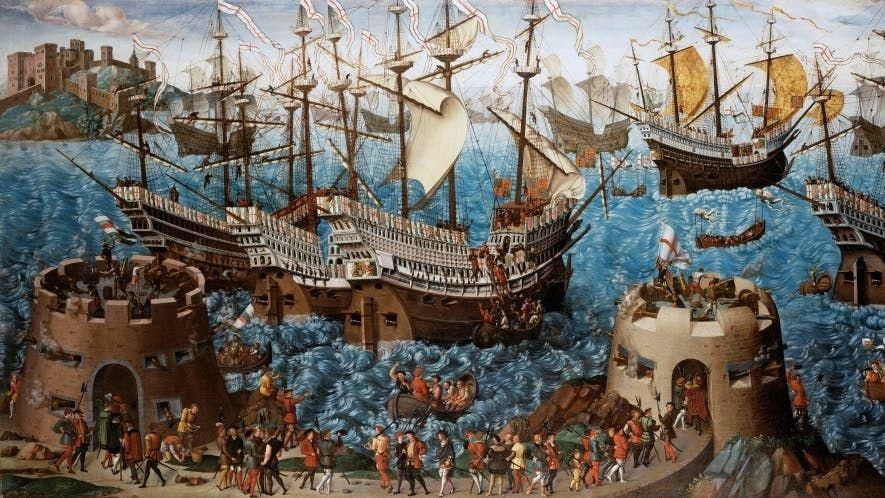Hampton Court: Ordinary lives and extraordinary times

- Published
The oldest rooms at Hampton Court Palace are now open to visitors - with a new exhibition about the ordinary men and women who enabled the Tudor court to flourish.
The Wolsey Rooms were originally built for Thomas Wolsey, Henry VIII's chief minister, when he owned Hampton Court in the 1520s.
The story of the dynasty is told through rare 16th-century artworks, historical objects and interactive displays at the palace, in the borough of Richmond in south-west London.
Portraits of the movers and shakers of the Tudor world include that of Catherine of Aragon - not just the first of Henry's six wives, but a member of one of Europe's most powerful families.
Violence and ambition
Soldiers and ordinary people are crushed by Henry’s political ambition in The Battle of the Spurs
The European adventures of Henry VIII and Wolsey are documented in three paintings.
The Battle of the Spurs records Henry’s victory against French armies in 1513, while also depicting the deadly violence of war.
Soldiers and ordinary people are crushed by Henry’s political ambition.
The Embarkation at Dover and The Field of Cloth of Gold depict the spectacular celebrations hosted by Henry and Francis I, King of France, in 1520.
The Field of Cloth of Gold shows a celebration held by the kings of France and England in 1520
Hürrem, also called La Rossa (because of her red hair), was an enslaved European woman sold to the Ottoman Sultan
Rivals of the Tudor dynasty also have their place in the exhibition.
In Europe, France and Spain battled for supremacy, while the Ottoman Empire expanded west from Asia.
One woman who was born without power, yet managed to acquire it, was Hürrem, also called La Rossa because of her red hair.
She was an enslaved European woman sold to Suleiman, the Ottoman Sultan.
Hürrem became his wife, rather than his concubine, and became involved in Ottoman politics.
She established help for the poor, was known to be intelligent and generous, and had a love of poetry. She also bore the sultan five sons and a daughter.
Tudor Woman in a Persian Dress, by Marcus Gheeraerts the Younger
The Tudor period was an age of discovery in science, art and fashion.
Europeans left their homes in search of trade and treasure - but voyages of exploration easily led to conflict and exploitation.
Rich Europeans could enjoy exotic foods and wear luxury fabrics from around the globe, but their fine clothes and jewellery were made from natural resources often plundered from Africa and the Americas.
Listen to the best of BBC Radio London on Sounds and follow BBC London on Facebook, external, X, external and Instagram, external. Send your story ideas to [email protected], external
Related Topics
- Published11 December 2023